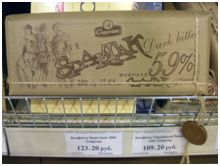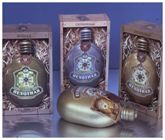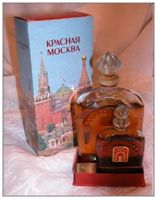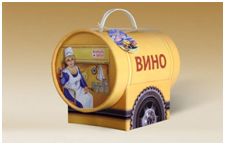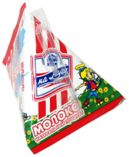By Peter Clarke, CEO and Founder of Product Ventures
Just over six months ago, I found myself in the southeastern most tip of Russia, called the Russian Far East, some 5000 miles from Moscow in a small and isolated town called Birobidzhan. The town, which we later learned was named after two rivers, the Bira, which runs through the town and the other, the Bidzhan, is located on the Trans-Siberian railway, close to the border with the People’s Republic of China. We were there waiting for the court approval of the adoption of our seven year old daughter, Inga. Though the six weeks in Birobidzhan and later in Moscow, seemed endless, my wife and I spent the time exploring the countryside attempting to better understand the culture and lifestyle of the Russian people and our soon-to-be daughter’s, historic heritage.
As a packaging expert and the founder of a global structural packaging agency, Product Ventures, I was intrigued by the brands, the designs and most importantly the packaging and the technologies that we encountered in our daily stops at the small, local grocery stores. We visited these stores many times over the course of our stay in Birobidzhan and later observed packaging at the larger, more modern, retailers that we saw in and around Moscow.
Curious about what I had seen and trying to better understand the thinking behind the development of Russian packaging, I did a little digging to find out about the history of Russian package design and the current trends in Russian packaging today. I was most interested in understanding the differences between the packaging designs we work on everyday for big brand, high-stakes, high-volume, fast-moving consumer goods and the challenges encountered when designing, developing and manufacturing packaging relevant to the Russian market.
History of Russian Packaging
It seems that years of communist rule are still evident in the design of Russian packaging, much of which reflects intricate detail and a pride in Russian folk art. In the early 1900’s much of the inspiration and design for packaging came from Russian artists, drawing on the country’s history and ethnicity to create memorable designs. Since the collapse of the Soviet Union in 1991, the packaging industry in Russia has seen major growth, increasing an average of 8-10% for food and beverage, cosmetics and tobacco products. After 1998, the Russian packaging industry gained additional momentum as imports on consumer products such as food, beverage and cosmetics, decreased. Today, Russian brands are updating and modernizing their packaging to compete with imported brands. Most recently, the Russian packaging industry has seen growth rates as high as 10-12% per year and has begun importing modern flexography printing presses to help update and improve the package decoration process.
Influence of Russian Customs on Packaging
We had the chance to speak with quite a few people during our travels, and even though language was sometimes a barrier to complete understanding, I was able to gather that Russian consumers think nostalgically about packaging. They yearn for the quality of “good old Soviet stuff” and see the appeal in its familiar and trustworthy value. This harkens back to the days of perceived stability under the Soviet Union, when packaging was more straight-forward and minimalistic. Indeed, when we went into some of the stores we saw quite a few products which, although obviously newer in nature, were actively attempting to imitate some of the older structures from decades ago.
I also noticed that Russian mythology and nature continue to be prominently displayed and embraced in Russian packaging designs. Forests and animals like wolves, bears and foxes are used frequently and symbolize the romance of the countryside and historic folktales. Visual religious symbols are seen on many products and packaging, particularly images such as Moscow’s Saint Basil’s Cathedral. Food has much symbolism for Russians and many of the food items found in the retail markets are highly regarded. Bread is a national symbol for life and hospitality, black caviar for luxury and abundance and mushrooms and berries, as gifts of the forests.
Iconic Russian Packaging: from vodka to perfume
I could not attempt to begin to understand Russian packaging, its symbols and its designs, without including a foray into the design of packaging for the iconic Russian vodka. Russia has been distilling vodka since the 15th century and it continues to play an enormous part in Russian culture today, with over 400 distilleries in existence and symbolizing camaraderie and communication. Traditionally vodka was packaged in glass bottles with gravure printed paper labels. Today vodka can be seen in packages with distinct designs and bottle shapes, differentiating the over 600 Russian brands of vodka.
Honey is one of the key export items of Russia and another area where Russian packaging design builds on the past. Traditionally, it is almost always packaged in a small wooden container, often sold along with a wooden spoon. The barrel is often lined with plastic film to prevent the honey from interacting with the wood. Today the “barrel” design and iconography is still widely used in packaging and distribution of Russian honey.
Fragrance packaging in Russia, is also very popular, and is heavily influenced by the French. This theme stemmed from Catherine the Great’s love of the French culture. In 1864 the first domestic perfume factory was established in Moscow, and the brand Krasnaya Moskva (Red Moscow) remains popular today. Packaging designs are often inspired by the Russian fashion industry, and the large growth seen in the Russian perfume and cosmetic industry is driven by improved packaging.
Utilitarian Value of Packaging
Two of the major factors in determining what is available for purchase in Russian grocery stores, have always been cost and transportation logistics. Unlike the US, where there is a significant middle class of consumers, it seemed that much of the Russian packaged offerings were geared either towards delivering basic necessities to the local consumers or being as low cost as possible. There didn’t seem to be much that reminded me of the vast arrays of product that we see in our supermarkets meant to attract those with a degree of disposable income. Because of the vast distance that products need to travel in Russia, those products that are not locally made need to be packaged to withstand the challenges of the distribution system, (lack of temperature control, rough handling), without failure. As a result of this the Russian packaging structures tend to be more simplistic and functional rather than aesthetically oriented. It is interesting to note though, that for large global brands, the packaging, especially in personal care and cleaning products, have made it to the far reaches of Birobidzhan. Since these packages are more robustly designed and often imported they have a shelf presence, even in the Russian Far East, similar to that seen in United States retailers.
Re-use of Plastic and Paper Goods
This utilitarian need for packaging seemed to be evident in the use of plastic and paper as well. When talking to many of the local consumers, it was discovered that plastic goods such as bottles and bags are often preserved and reused. Two-liter bottles of soda are often re-used for purchasing drinks that are dispensed straight from a large barrel. For example, the drink Kvas which is a “fermented beverage” is rolled out in large barrels near the markets and people bring all of their empty two-liter bottles with them to be filled with this drink. Plastic bags are rarely thrown out and are re-used until they practically fall apart. This behavior is definitely inspired by difficult times and the communist viewpoint of “making the best of what you have” and not being wasteful. But, it also serves as a reminder of the scarcity of paper goods. Oftentimes we were given paper napkins very sparingly, along with grocery receipts. Russia’s pulp and paper processing facilities lack the technical skills, equipment and capacity to produce quality paper products. Much of the equipment in place in the industry is old and outdated. Today, many quality paper products are imported, since the scale of investment required to modernize Russia’s pulp and paper converting infrastructure would be huge. This helps to explain why we saw much use of “second life packaging”- packaging that was reused once its original purpose of delivering the product to the consumer had been fulfilled.
Packaging in Moscow
In Moscow, when I had the chance to visit some of the larger retail stores, I came across a broader variety of packaged products and found that there was more shelf space available. However, I was astonished by the amount of “gimmicks” that were incorporated into and onto the packages, most without any real continuity across product lines, in order to help entice the consumer to purchase the product. New technologies in packaging were concentrated in and around this area and although Russians are eager to borrow and learn from the west, innovation costs money and it seems as though Russian consumers are not quite ready to pay for it.
In Moscow supermarkets, I saw the classic Tetra Pak milk “brik”, and although it was invented by a Swedish company, it seemed to embody many of the Russian sensibilities I had discovered in my travels. The popularity of this design seems to speak to the practicality of packaging in much of Russia, utilizing materials in the best possible way, being simple and straight forward, and being able to be distributed over long distances without the need for refrigeration. The limited capabilities for cold chain distribution and the vast distances that packaged food products need to travel across Russia, make the use of shelf stable packaging formats (retort, aseptic) especially suited to the needs of food supply in Russia.
Appreciation of cultural and historical heritage on packaging
As a packaging expert who has worked with many of the largest global companies in the world, I was able, during my six weeks stay, to put on my packaging lens to view Russian brands from both a consumer’s and a designer’s point of view. I was able to see what makes Russian packaging design different from European and American packaging. By immersing myself in the Russian way of life, I found myself having a deeper appreciation of the cultural and historical heritage which has always influenced Russian package design. Someday, we look forward to sharing with our daughter, our new understanding of her culture, that of a country which upholds the value of its deep history and ancient folklore.
About the Author
CEO Peter Clarke is a visionary entrepreneur who founded Product Ventures for the research, design and development of manufactured goods. Most recently Brandweek Magazine called Peter Clarke, “the packaging design guru”.
